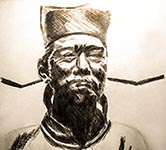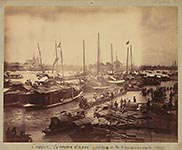CHINA
ref. # 037d china -Zheng He
 ZHENG He (1371-1433 or 1435), originally named Ma He, was a Hui court eunuch, mariner, explorer, diplomat, and fleet admiral during China's early Ming dynasty. Zheng commanded expeditionary voyages to Southeast Asia, South Asia, Western Asia, and East Africa from 1405 to 1433. His larger ships stretched 400 feet in length (Columbus's Santa Maria was 85 feet). These carried hundreds of sailors on four tiers of decks.
ZHENG He (1371-1433 or 1435), originally named Ma He, was a Hui court eunuch, mariner, explorer, diplomat, and fleet admiral during China's early Ming dynasty. Zheng commanded expeditionary voyages to Southeast Asia, South Asia, Western Asia, and East Africa from 1405 to 1433. His larger ships stretched 400 feet in length (Columbus's Santa Maria was 85 feet). These carried hundreds of sailors on four tiers of decks.As a favorite of the Yongle Emperor, whose usurpation he assisted, he rose to the top of the imperial hierarchy and served as commander of the southern capital Nanjing (the capital was later moved to Beijing by the Yongle Emperor). These voyages were long neglected in official Chinese histories but have become well known in China and abroad since the publication of Liang Qichao's Biography of Our Homeland's Great Navigator, Zheng He in 1904. A trilingual stele left by the navigator was discovered on the island of Sri Lanka shortly thereafter.
©: text: Wikipedia, painting: internet, source unknown
tags: #Zheng He #china
Mao Kun Map, alledgedly the map of ZHENG HE
ref. # 037a china -Star Chart
 Ink rubbing of a stele at the Confucian Temple, Suzhou, Jiangsu province
Ink rubbing of a stele at the Confucian Temple, Suzhou, Jiangsu provinceSouthern Song dynasty, Chunyou reign, dated 1247
Hanging scroll; ink on paper
183 x 100 cm
©: Stone Carving Museum, Suzhou; the Art Institute of Chicago
tags: #star chart
ref. # 037b china -Zhen Kuo
 Shen Kuo (1031-1095) was a noted Chinese scientist, a general and a public official. Shen wrote the first description of a magnetic compass; he had discovered true north centuries before Christians or Muslims did. He was the first man in China to write of both retrograde motion and atmospheric refraction. He was the first there to use a camera obscura as well; he did the earliest known complex optical experiments in the world with one. He used a sighting tube that he had built to make the first accurate map in his native land of the Pole star in more than 600 years. He was the first man in China to say that the Sun, the Moon, and the planets were all spheres. As with all in that realm, he thought that the Earth was flat.
Shen Kuo (1031-1095) was a noted Chinese scientist, a general and a public official. Shen wrote the first description of a magnetic compass; he had discovered true north centuries before Christians or Muslims did. He was the first man in China to write of both retrograde motion and atmospheric refraction. He was the first there to use a camera obscura as well; he did the earliest known complex optical experiments in the world with one. He used a sighting tube that he had built to make the first accurate map in his native land of the Pole star in more than 600 years. He was the first man in China to say that the Sun, the Moon, and the planets were all spheres. As with all in that realm, he thought that the Earth was flat.©: http://www.nmspacemuseum.org/documents/CurationPaper1.pdf
tags: #Shen Kuo
ref. # 037c china -Auguste François 'Port of Canton'
 á Canton: la rivière et le port vu de la rive droite du Quai Fati (Huadi) 1887
á Canton: la rivière et le port vu de la rive droite du Quai Fati (Huadi) 1887©: www.photographyofchina.com
tags: #Canton
ref. # 037e from China to Japan -Kozuka with Daruma
 "Daruma (Sk. Bodhidharma) was an Indian Buddhist who lived in the 6th century. He is recognized as the founder of Zen Buddhism. Legends claim that he traveled to China and Japan. Here he is shown standing on a reed, which he used to cross the ocean from China to Japan. The artist's signature and seal are on the reverse."
"Daruma (Sk. Bodhidharma) was an Indian Buddhist who lived in the 6th century. He is recognized as the founder of Zen Buddhism. Legends claim that he traveled to China and Japan. Here he is shown standing on a reed, which he used to cross the ocean from China to Japan. The artist's signature and seal are on the reverse."Iwamoto KONKAN (Japanese, 1744-1801)
Period: 1744-1801 (Edo), Medium: shibuichi, gold (Arms & Armor), Accession number: 51.739, Measurements: 3 3/4 in. (9.5 cm) (l.), Geographies: Edo (present-day Tokyo, Japan) (Place of Origin),
©: CC The Walters Art Museum
tags: #china #japan #religion
